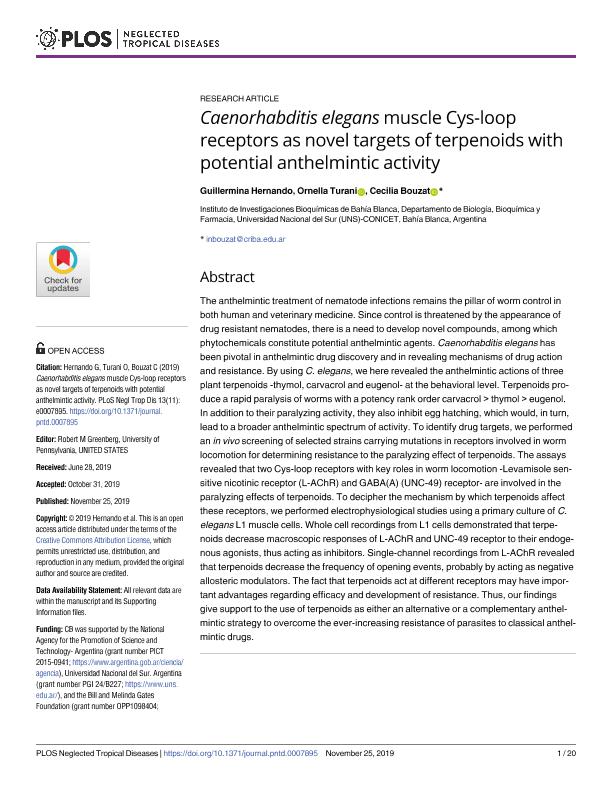Mostrar el registro sencillo del ítem
dc.contributor.author
Hernando, Guillermina Silvana

dc.contributor.author
Turani, Ornella

dc.contributor.author
Bouzat, Cecilia Beatriz

dc.date.available
2020-03-10T18:53:55Z
dc.date.issued
2019-11
dc.identifier.citation
Hernando, Guillermina Silvana; Turani, Ornella; Bouzat, Cecilia Beatriz; Caenorhabditis elegans muscle Cys-loop receptors as novel targets of terpenoids with potential anthelmintic activity; Public Library of Science; PLoS Neglected Tropical Diseases; 13; 11; 11-2019
dc.identifier.issn
1935-2735
dc.identifier.uri
http://hdl.handle.net/11336/99047
dc.description.abstract
The anthelmintic treatment of nematode infections remains the pillar of worm control in both human and veterinary medicine. Since control is threatened by the appearance of drug resistant nematodes, there is a need to develop novel compounds, among which phytochemicals constitute potential anthelmintic agents. Caenorhabditis elegans has been pivotal in anthelmintic drug discovery and in revealing mechanisms of drug action and resistance. By using C. elegans, we here revealed the anthelmintic actions of three plant terpenoids -thymol, carvacrol and eugenol- at the behavioral level. Terpenoids produce a rapid paralysis of worms with a potency rank order carvacrol > thymol > eugenol. In addition to their paralyzing activity, they also inhibit egg hatching, which would, in turn, lead to a broader anthelmintic spectrum of activity. To identify drug targets, we performed an in vivo screening of selected strains carrying mutations in receptors involved in worm locomotion for determining resistance to the paralyzing effect of terpenoids. The assays revealed that two Cys-loop receptors with key roles in worm locomotion -Levamisole sensitive nicotinic receptor (L-AChR) and GABA(A) (UNC-49) receptor- are involved in the paralyzing effects of terpenoids. To decipher the mechanism by which terpenoids affect these receptors, we performed electrophysiological studies using a primary culture of C. elegans L1 muscle cells. Whole cell recordings from L1 cells demonstrated that terpenoids decrease macroscopic responses of L-AChR and UNC-49 receptor to their endogenous agonists, thus acting as inhibitors. Single-channel recordings from L-AChR revealed that terpenoids decrease the frequency of opening events, probably by acting as negative allosteric modulators. The fact that terpenoids act at different receptors may have important advantages regarding efficacy and development of resistance. Thus, our findings give support to the use of terpenoids as either an alternative or a complementary anthelmintic strategy to overcome the ever-increasing resistance of parasites to classical anthelmintic drugs.
dc.format
application/pdf
dc.language.iso
eng
dc.publisher
Public Library of Science

dc.rights
info:eu-repo/semantics/openAccess
dc.rights.uri
https://creativecommons.org/licenses/by/2.5/ar/
dc.subject
TERPENOIDS
dc.subject
CYS-LOOP RECEPTORS
dc.subject
ANTHELMINTIC ACTIVITY
dc.subject.classification
Bioquímica y Biología Molecular

dc.subject.classification
Ciencias Biológicas

dc.subject.classification
CIENCIAS NATURALES Y EXACTAS

dc.title
Caenorhabditis elegans muscle Cys-loop receptors as novel targets of terpenoids with potential anthelmintic activity
dc.type
info:eu-repo/semantics/article
dc.type
info:ar-repo/semantics/artículo
dc.type
info:eu-repo/semantics/publishedVersion
dc.date.updated
2020-02-26T20:08:14Z
dc.journal.volume
13
dc.journal.number
11
dc.journal.pais
Estados Unidos

dc.journal.ciudad
California
dc.description.fil
Fil: Hernando, Guillermina Silvana. Universidad Nacional del Sur. Departamento de Biología, Bioquímica y Farmacia; Argentina. Consejo Nacional de Investigaciones Científicas y Técnicas. Centro Científico Tecnológico Conicet - Bahía Blanca. Instituto de Investigaciones Bioquímicas de Bahía Blanca. Universidad Nacional del Sur. Instituto de Investigaciones Bioquímicas de Bahía Blanca; Argentina
dc.description.fil
Fil: Turani, Ornella. Consejo Nacional de Investigaciones Científicas y Técnicas. Centro Científico Tecnológico Conicet - Bahía Blanca. Instituto de Investigaciones Bioquímicas de Bahía Blanca. Universidad Nacional del Sur. Instituto de Investigaciones Bioquímicas de Bahía Blanca; Argentina. Universidad Nacional del Sur. Departamento de Biología, Bioquímica y Farmacia; Argentina
dc.description.fil
Fil: Bouzat, Cecilia Beatriz. Consejo Nacional de Investigaciones Científicas y Técnicas. Centro Científico Tecnológico Conicet - Bahía Blanca. Instituto de Investigaciones Bioquímicas de Bahía Blanca. Universidad Nacional del Sur. Instituto de Investigaciones Bioquímicas de Bahía Blanca; Argentina. Universidad Nacional del Sur. Departamento de Biología, Bioquímica y Farmacia; Argentina
dc.journal.title
PLoS Neglected Tropical Diseases

dc.relation.alternativeid
info:eu-repo/semantics/altIdentifier/url/https://journals.plos.org/plosntds/article?id=10.1371/journal.pntd.0007895
dc.relation.alternativeid
info:eu-repo/semantics/altIdentifier/doi/http://dx.doi.org/10.1371/journal.pntd.0007895
Archivos asociados
